Deck 2: Language and the Brain
Question
Question
Question
Question
Question
Question
Question
Question
Question
Question
Question
Question
Question
Question
Question
Question
Question
Question
Question
Question
Question
Question
Question
Question
Question
Question
Question
Question
Question
Question
Question
Question
Question
Question
Question
Question
Question
Question
Question
Question
Question

Unlock Deck
Sign up to unlock the cards in this deck!
Unlock Deck
Unlock Deck
1/41
Play
Full screen (f)
Deck 2: Language and the Brain
1
A neurolinguist would most likely study
A) the physical organization of the cerebral cortex, including fissures, grooves and the vessels that transport blood and nutrients throughout this system.
B) how a lesion in Wernicke's area might affect language production.
C) the effects of dopamine on depression.
D) the effects of moving to a new school on children's self esteem.
A) the physical organization of the cerebral cortex, including fissures, grooves and the vessels that transport blood and nutrients throughout this system.
B) how a lesion in Wernicke's area might affect language production.
C) the effects of dopamine on depression.
D) the effects of moving to a new school on children's self esteem.
B
2
Which of the following sentences would you expect a patient with Broca's aphasia to have the most difficulty understanding?
A) The dog bit the man.
B) The sorbet that the lady is eating is sour.
C) The girl who the boy is pushing is big.
D) The mail carrier who the dog bit called the police.
A) The dog bit the man.
B) The sorbet that the lady is eating is sour.
C) The girl who the boy is pushing is big.
D) The mail carrier who the dog bit called the police.
C
3
The cerebral cortex is
A) smooth with little or no convolutions.
B) the outermost layer of neurons covering the brain.
C) only used 10% of the time.
D) only found in humans.
A) smooth with little or no convolutions.
B) the outermost layer of neurons covering the brain.
C) only used 10% of the time.
D) only found in humans.
B
4
Scientists in Phineas Gage's time
A) knew a great deal about how the brain is organized and which cerebral areas are responsible for which cognitive abilities.
B) were just beginning to decipher the relationship between the physical components of the brain and their relationship to human behavior.
C) used sophisticated methodologies and techniques to indentify how the physical brain relates to human behavior.
D) had little interest in understanding the relationship between neural components and behavior.
A) knew a great deal about how the brain is organized and which cerebral areas are responsible for which cognitive abilities.
B) were just beginning to decipher the relationship between the physical components of the brain and their relationship to human behavior.
C) used sophisticated methodologies and techniques to indentify how the physical brain relates to human behavior.
D) had little interest in understanding the relationship between neural components and behavior.

Unlock Deck
Unlock for access to all 41 flashcards in this deck.
Unlock Deck
k this deck
5
Studies such as those published by Nina Dronkers and her colleagues (2004) indicate that language functioning
A) is contained within specific, independent brain "organs."
B) is affected in similar ways regardless of where in the brain damage occurs.
C) is distributed across several different brain regions.
D) can be restored even in cases of severe brain injury.
A) is contained within specific, independent brain "organs."
B) is affected in similar ways regardless of where in the brain damage occurs.
C) is distributed across several different brain regions.
D) can be restored even in cases of severe brain injury.

Unlock Deck
Unlock for access to all 41 flashcards in this deck.
Unlock Deck
k this deck
6
Voxel-based lesion-symptom mapping (VLSM) is most useful because it allows researchers to
A) precisely correlate diminished performance with damage to specific parts of the brain.
B) study the impact of brain lateralization.
C) identify and define Brodmann areas.
D) assess language comprehension in aphasic patients.
A) precisely correlate diminished performance with damage to specific parts of the brain.
B) study the impact of brain lateralization.
C) identify and define Brodmann areas.
D) assess language comprehension in aphasic patients.

Unlock Deck
Unlock for access to all 41 flashcards in this deck.
Unlock Deck
k this deck
7
Broca's aphasia is characterized by a patient's inability to
A) understand spoken language.
B) understand written text.
C) speak fluently.
D) understand the function of objects in their environment.
A) understand spoken language.
B) understand written text.
C) speak fluently.
D) understand the function of objects in their environment.

Unlock Deck
Unlock for access to all 41 flashcards in this deck.
Unlock Deck
k this deck
8
Which would you expect to be especially difficult for a patient with Broca's aphasia?
A) Understanding a political candidate's speech
B) Delivering a speech without pauses or hesitations
C) Getting the gist of an audiobook
D) Following a movie that has a great deal of dialogue
A) Understanding a political candidate's speech
B) Delivering a speech without pauses or hesitations
C) Getting the gist of an audiobook
D) Following a movie that has a great deal of dialogue

Unlock Deck
Unlock for access to all 41 flashcards in this deck.
Unlock Deck
k this deck
9
A person with Wernicke's aphasia will demonstrate
A) halting speech.
B) inability to produce speech.
C) nonsensical speech.
D) normal ability to comprehend speech.
A) halting speech.
B) inability to produce speech.
C) nonsensical speech.
D) normal ability to comprehend speech.

Unlock Deck
Unlock for access to all 41 flashcards in this deck.
Unlock Deck
k this deck
10
A physician asks four patients with aphasia to describe how to make a peanut butter sandwich. Which response most likely came from a patient with Wernicke's aphasia?
A) "Sure, no problem. Open the jar and, uh, uh, uh … peanut, oops, no, no knife …spread and, uh … bread … sprea-ding … jeeelly … wait …"
B) "I'd put a glob of peanut butter from the jar onto a knife, spread it onto one piece of bread, put some jelly on another slice of bread, spread that, and then put the two pieces of bread together."
C) "Me like peanuts. Me spread. Jelly on bread. Put together. Me eat."
D) "Obviously I'd think it's utzkin, though certainly I do want to go when it's vehubative. I would recommend placing a spoon in the bowl. I do wobble and frink."
A) "Sure, no problem. Open the jar and, uh, uh, uh … peanut, oops, no, no knife …spread and, uh … bread … sprea-ding … jeeelly … wait …"
B) "I'd put a glob of peanut butter from the jar onto a knife, spread it onto one piece of bread, put some jelly on another slice of bread, spread that, and then put the two pieces of bread together."
C) "Me like peanuts. Me spread. Jelly on bread. Put together. Me eat."
D) "Obviously I'd think it's utzkin, though certainly I do want to go when it's vehubative. I would recommend placing a spoon in the bowl. I do wobble and frink."

Unlock Deck
Unlock for access to all 41 flashcards in this deck.
Unlock Deck
k this deck
11
A surgeon conducting an autopsy on a patient who had suffered from Broca's aphasia would most likely find damage in the
A) corpus callosum.
B) right frontal lobe.
C) left occipital lobe.
D) left frontal lobe.
A) corpus callosum.
B) right frontal lobe.
C) left occipital lobe.
D) left frontal lobe.

Unlock Deck
Unlock for access to all 41 flashcards in this deck.
Unlock Deck
k this deck
12
Wilder Penfield's research on the localization of function in the brain demonstrated that when Broca's area is stimulated in a conscious person,
A) the effect is always the same; namely that the ability to understand language is disrupted.
B) the effect is always the same; namely that the ability to produce language is disrupted.
C) although the effect may be varied, depending on the individual being stimulated, it will likely be related to linguistic abilities.
D) although the effect may be varied, depending on the individual being stimulated, it will likely be related to non-linguistic abilities.
A) the effect is always the same; namely that the ability to understand language is disrupted.
B) the effect is always the same; namely that the ability to produce language is disrupted.
C) although the effect may be varied, depending on the individual being stimulated, it will likely be related to linguistic abilities.
D) although the effect may be varied, depending on the individual being stimulated, it will likely be related to non-linguistic abilities.

Unlock Deck
Unlock for access to all 41 flashcards in this deck.
Unlock Deck
k this deck
13
You are examining a split-brain patient. After flashing a picture of a bird in the patient's left visual field, which response are you likely to get?
A) The patient says "bird" but is unable to chirp.
B) The patient says "bird" and points to a bird with the left hand.
C) The patient points to a bird with the right hand but is unable to say "bird."
D) The patient points to a bird with the left hand but is unable to say "bird."
A) The patient says "bird" but is unable to chirp.
B) The patient says "bird" and points to a bird with the left hand.
C) The patient points to a bird with the right hand but is unable to say "bird."
D) The patient points to a bird with the left hand but is unable to say "bird."

Unlock Deck
Unlock for access to all 41 flashcards in this deck.
Unlock Deck
k this deck
14
A(n) _______ is evident if one patient exhibits a language impairment with normal mathematical abilities and another patient exhibits a mathematical impairment with normal language.
A) hemodynamic change
B) localization
C) double dissociation
D) action potential
A) hemodynamic change
B) localization
C) double dissociation
D) action potential

Unlock Deck
Unlock for access to all 41 flashcards in this deck.
Unlock Deck
k this deck
15
When designing an fMRI study, which would be the best strategy for isolating the neural activity associated with the vocal component of reading a word from other potential actions related to reading?
A) Compare fMRI scans of a subject silently reading a word and of reading the word aloud.
B) Compare fMRI scans of a subject looking at a picture that is related to a word and of reading the word aloud.
C) Compare a PET scan of a subject reading a word aloud to an fMRI scan of a subject reading the same word aloud.
D) Perform an fMRI scan of the participant as he is talking to a friend, noting the level of brain activity when he uses the target word.
A) Compare fMRI scans of a subject silently reading a word and of reading the word aloud.
B) Compare fMRI scans of a subject looking at a picture that is related to a word and of reading the word aloud.
C) Compare a PET scan of a subject reading a word aloud to an fMRI scan of a subject reading the same word aloud.
D) Perform an fMRI scan of the participant as he is talking to a friend, noting the level of brain activity when he uses the target word.

Unlock Deck
Unlock for access to all 41 flashcards in this deck.
Unlock Deck
k this deck
16
In a 2004 fMRI study of word reading, Olaf Hauk and his colleagues demonstrated that language-specific brain regions
A) are the only regions responsible for interpreting and producing spoken language.
B) are not the only areas activated by certain categories of words related to physical acts, such as kicking, stepping, or walking.
C) are highly localized and respond primarily to written language.
D) rarely interact with regions responsible for action or movement.
A) are the only regions responsible for interpreting and producing spoken language.
B) are not the only areas activated by certain categories of words related to physical acts, such as kicking, stepping, or walking.
C) are highly localized and respond primarily to written language.
D) rarely interact with regions responsible for action or movement.

Unlock Deck
Unlock for access to all 41 flashcards in this deck.
Unlock Deck
k this deck
17
Wernicke believed that language processing was
A) highly compartmentalized in the brain, with specific modules communicating in pre-set patterns.
B) distributed throughout the brain in a highly coordinated network.
C) localized in one specific brain area.
D) strictly contained in the left hemisphere.
A) highly compartmentalized in the brain, with specific modules communicating in pre-set patterns.
B) distributed throughout the brain in a highly coordinated network.
C) localized in one specific brain area.
D) strictly contained in the left hemisphere.

Unlock Deck
Unlock for access to all 41 flashcards in this deck.
Unlock Deck
k this deck
18
While the dorsal stream is responsible for "_______" information, the ventral stream provides us with a path for knowledge about "_______" information.
A) where; how
B) how; what
C) who; what
D) what; how
A) where; how
B) how; what
C) who; what
D) what; how

Unlock Deck
Unlock for access to all 41 flashcards in this deck.
Unlock Deck
k this deck
19
During a visit to a coffee shop, a patient who has a lesion along the dorsal stream of information processing would have the most trouble
A) identifying liquid in a mug as coffee.
B) understanding the items on the menu.
C) reaching for his coffee without knocking it over.
D) remembering the name of the server.
A) identifying liquid in a mug as coffee.
B) understanding the items on the menu.
C) reaching for his coffee without knocking it over.
D) remembering the name of the server.

Unlock Deck
Unlock for access to all 41 flashcards in this deck.
Unlock Deck
k this deck
20
Which of the following is an example of procedural memory?
A) Recalling the author of a favorite poem
B) Remembering the contents of a painting
C) Remembering how to ski
D) Recalling a zip code
A) Recalling the author of a favorite poem
B) Remembering the contents of a painting
C) Remembering how to ski
D) Recalling a zip code

Unlock Deck
Unlock for access to all 41 flashcards in this deck.
Unlock Deck
k this deck
21
In terms of memory systems, declarative recall is to _______ as procedural recall is to _______.
A) remembering the date of your mother's birthday; flipping pancakes
B) flipping pancakes; remembering your zip code
C) remembering your zip code; remembering your phone number
D) riding a skateboard; flipping pancakes
A) remembering the date of your mother's birthday; flipping pancakes
B) flipping pancakes; remembering your zip code
C) remembering your zip code; remembering your phone number
D) riding a skateboard; flipping pancakes

Unlock Deck
Unlock for access to all 41 flashcards in this deck.
Unlock Deck
k this deck
22
A deaf ASL signer suffering from Broca's aphasia would
A) have a difficult time mimicking and lip reading what a hearing person was trying to convey.
B) have a difficult time understanding what other signers are signing in ASL.
C) have difficulty interpreting pantomime signs produced by hearing individuals.
D) have a difficult time generating ASL signs they once knew well.
A) have a difficult time mimicking and lip reading what a hearing person was trying to convey.
B) have a difficult time understanding what other signers are signing in ASL.
C) have difficulty interpreting pantomime signs produced by hearing individuals.
D) have a difficult time generating ASL signs they once knew well.

Unlock Deck
Unlock for access to all 41 flashcards in this deck.
Unlock Deck
k this deck
23
A nineteenth century phrenologist would most likely be found
A) using psychoanalytic techniques to investigate a client's personality characteristics.
B) describing a client's psychological traits based on the physical attributes on a client's skull.
C) conducting neural surgery to help patients with physical brain trauma.
D) mapping brain regions using patients with brain trauma.
A) using psychoanalytic techniques to investigate a client's personality characteristics.
B) describing a client's psychological traits based on the physical attributes on a client's skull.
C) conducting neural surgery to help patients with physical brain trauma.
D) mapping brain regions using patients with brain trauma.

Unlock Deck
Unlock for access to all 41 flashcards in this deck.
Unlock Deck
k this deck
24
fMRI scans would find that English and Mandarin speakers
A) both process tone information in the right hemisphere.
B) both process tone information in the left hemispheres.
C) process tone information differentially, with Mandarin speakers showing activation in the language areas for tones and English speakers showing activation in non-linguistic, sound processing regions.
D) process tone information differentially, with English speakers showing activation in the language areas for tones and Mandarin speakers showing activation in non-linguistic, sound processing regions.
A) both process tone information in the right hemisphere.
B) both process tone information in the left hemispheres.
C) process tone information differentially, with Mandarin speakers showing activation in the language areas for tones and English speakers showing activation in non-linguistic, sound processing regions.
D) process tone information differentially, with English speakers showing activation in the language areas for tones and Mandarin speakers showing activation in non-linguistic, sound processing regions.

Unlock Deck
Unlock for access to all 41 flashcards in this deck.
Unlock Deck
k this deck
25
Information flows through a neuron from
A) synapse to cell body to dendrites to axon.
B) dendrites to cell body to axon to synapse.
C) cell body to dendrites to synapse to axon.
D) axon to cell body to synapse to dendrites.
A) synapse to cell body to dendrites to axon.
B) dendrites to cell body to axon to synapse.
C) cell body to dendrites to synapse to axon.
D) axon to cell body to synapse to dendrites.

Unlock Deck
Unlock for access to all 41 flashcards in this deck.
Unlock Deck
k this deck
26
Refer to figures A and B 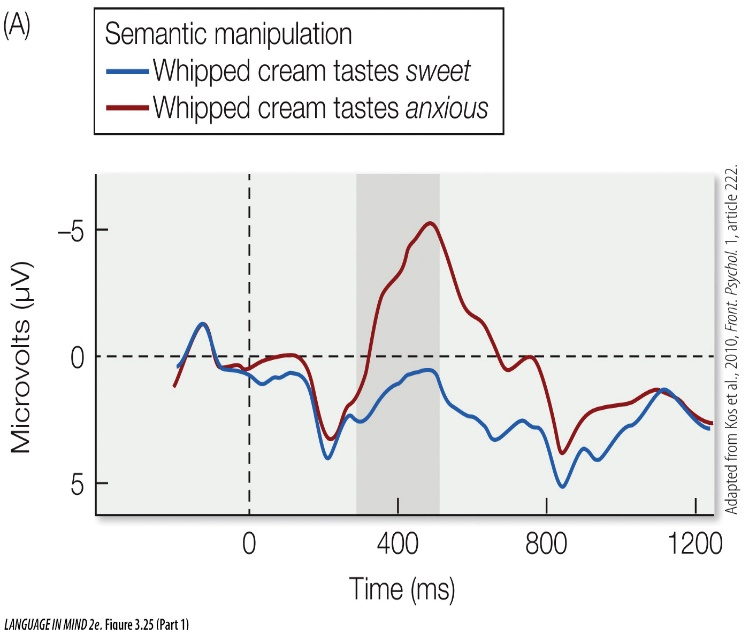
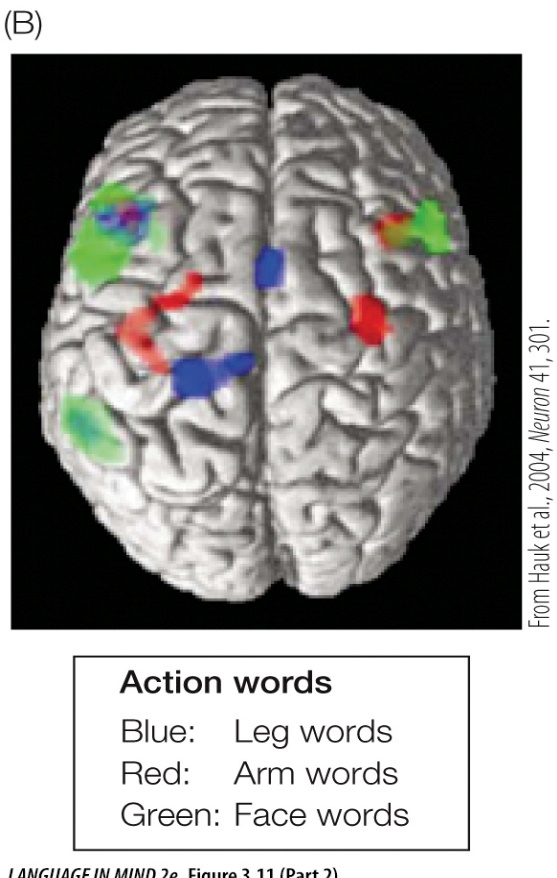
A) fMRI scans can be conducted on live participants whereas ERPs are dangerous for live participant research.
B) ERPs provide a more precise position for activation of linguistic processing areas in the brain than do fMRI scans.
C) fMRI scans provide more precise representations of the latency of language activation than do ERP measures.
D) ERPs provide real-time information about the time course of language whereas fMRI data lag by a few seconds in demonstrating activity sequences.


A) fMRI scans can be conducted on live participants whereas ERPs are dangerous for live participant research.
B) ERPs provide a more precise position for activation of linguistic processing areas in the brain than do fMRI scans.
C) fMRI scans provide more precise representations of the latency of language activation than do ERP measures.
D) ERPs provide real-time information about the time course of language whereas fMRI data lag by a few seconds in demonstrating activity sequences.

Unlock Deck
Unlock for access to all 41 flashcards in this deck.
Unlock Deck
k this deck
27
Imagine you are conducting an ERP study. You would expect to see an N400 waveform produced as a result of the italicized stimulus word in this sentence:
A) "I like to eat toast."
B) "Toast is what I like to jump."
C) "I will jumped on the trampoline."
D) "Stephanie likes to eat ripe umbrellas."
A) "I like to eat toast."
B) "Toast is what I like to jump."
C) "I will jumped on the trampoline."
D) "Stephanie likes to eat ripe umbrellas."

Unlock Deck
Unlock for access to all 41 flashcards in this deck.
Unlock Deck
k this deck
28
Imagine you are conducting an ERP study. You would expect to see a P600 waveform as a result of the italicized stimulus word in this sentence:
A) "I will jump on the trampoline."
B) "Stephanie likes to eat unripe umbrellas."
C) "Stephanie likes to eat ripe umbrellas."
D) "I will jumped on the trampoline."
A) "I will jump on the trampoline."
B) "Stephanie likes to eat unripe umbrellas."
C) "Stephanie likes to eat ripe umbrellas."
D) "I will jumped on the trampoline."

Unlock Deck
Unlock for access to all 41 flashcards in this deck.
Unlock Deck
k this deck
29
You are a physician working with patients who have been diagnosed as being in a vegetative state. If you present these patients with various types of auditory stimuli, you would likely find that
A) none of the patients ever demonstrated any ERP activity due to their lack of consciousness.
B) some patients produce ERP activity in response to the auditory stimuli of their names.
C) some patients produce a variety of strong and distinct ERP activation when presented with action words.
D) it is impossible to determine if any of the patients retain any cognitive abilities.
A) none of the patients ever demonstrated any ERP activity due to their lack of consciousness.
B) some patients produce ERP activity in response to the auditory stimuli of their names.
C) some patients produce a variety of strong and distinct ERP activation when presented with action words.
D) it is impossible to determine if any of the patients retain any cognitive abilities.

Unlock Deck
Unlock for access to all 41 flashcards in this deck.
Unlock Deck
k this deck
30
_______ is characterized by the inability to make sense of music while language comprehension remains unaffected.
A) Amusia
B) Insomnia
C) Aphasia
D) Arabia
A) Amusia
B) Insomnia
C) Aphasia
D) Arabia

Unlock Deck
Unlock for access to all 41 flashcards in this deck.
Unlock Deck
k this deck
31
The symptoms exhibited by _______ and _______ illustrate a double dissociation.
A) split brain; amusia
B) Wernicke's aphasia; auditory verbal agnosia
C) auditory verbal agnosia; amusia
D) amusia; Broca's aphasia
A) split brain; amusia
B) Wernicke's aphasia; auditory verbal agnosia
C) auditory verbal agnosia; amusia
D) amusia; Broca's aphasia

Unlock Deck
Unlock for access to all 41 flashcards in this deck.
Unlock Deck
k this deck
32
Sanjay is a patient with distinct damage to Broca's area, but he doesn't seem to exhibit the constellation of language impairments that characterize Broca's aphasia. Judy is a patient with fairly widespread damage to the left hemisphere, not limited to Broca's area, and she has been diagnosed with Broca's aphasia but with only some of the traditional symptoms. Explain the implications of these findings.

Unlock Deck
Unlock for access to all 41 flashcards in this deck.
Unlock Deck
k this deck
33
If MRIs were available in Phineas Gage's time, what kinds of conclusions could a researcher draw from the information available from an MRI scan his of brain after his accident? How might this information contribute to our study of the relationship between the brain and behavior?

Unlock Deck
Unlock for access to all 41 flashcards in this deck.
Unlock Deck
k this deck
34
Refer to the figure.
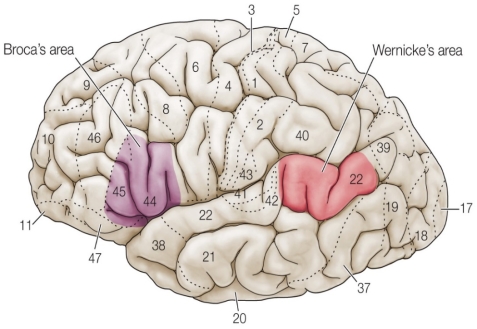 Identify Broca's and Wernicke's areas, and summarize the types of linguistic deficits that patients with lesions in each would typically experience. Provide an example of spoken language that would represent lesions in each of these two cortical regions.
Identify Broca's and Wernicke's areas, and summarize the types of linguistic deficits that patients with lesions in each would typically experience. Provide an example of spoken language that would represent lesions in each of these two cortical regions.
 Identify Broca's and Wernicke's areas, and summarize the types of linguistic deficits that patients with lesions in each would typically experience. Provide an example of spoken language that would represent lesions in each of these two cortical regions.
Identify Broca's and Wernicke's areas, and summarize the types of linguistic deficits that patients with lesions in each would typically experience. Provide an example of spoken language that would represent lesions in each of these two cortical regions.
Unlock Deck
Unlock for access to all 41 flashcards in this deck.
Unlock Deck
k this deck
35
If you were trying to identify the brain areas responsible for speech recognition, how useful would it be to compare fMRI scans of participants who heard spoken language with those who actively read aloud the same script from a monitor? Would a direct comparison of scans in these two conditions allow you to identify the areas responsible for speech recognition? Why or why not?

Unlock Deck
Unlock for access to all 41 flashcards in this deck.
Unlock Deck
k this deck
36
Refer to the figure.
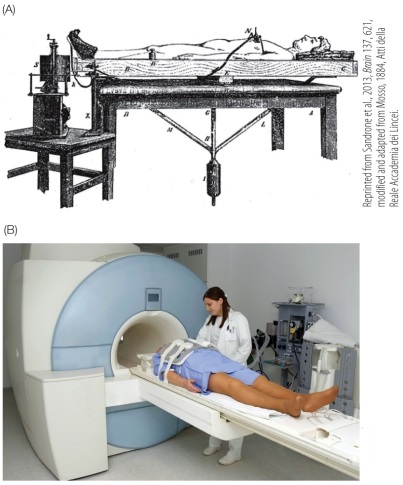 How do each of the machines, depicted in A and B, attempt to provide evidence for mental activity? What theoretical assumption is shared by both machines? Compare the data each produces and argue which is more useful and why.
How do each of the machines, depicted in A and B, attempt to provide evidence for mental activity? What theoretical assumption is shared by both machines? Compare the data each produces and argue which is more useful and why.
 How do each of the machines, depicted in A and B, attempt to provide evidence for mental activity? What theoretical assumption is shared by both machines? Compare the data each produces and argue which is more useful and why.
How do each of the machines, depicted in A and B, attempt to provide evidence for mental activity? What theoretical assumption is shared by both machines? Compare the data each produces and argue which is more useful and why.
Unlock Deck
Unlock for access to all 41 flashcards in this deck.
Unlock Deck
k this deck
37
Briefly summarize the outcome and conclusions of Hauk and colleagues' 2004 fMRI study investigating where and how action words are processed in the brain. What does this reveal about localization?

Unlock Deck
Unlock for access to all 41 flashcards in this deck.
Unlock Deck
k this deck
38
Imagine that you are a psycholinguist working with a deaf ASL signer who is having trouble remembering and producing ASL signs that they once knew well but is able to carry out actions such as pouring coffee. Would you expect that any brain damage that you found would be in language-specific brain areas such as Broca's or motor-specific areas such as the primary motor cortex?

Unlock Deck
Unlock for access to all 41 flashcards in this deck.
Unlock Deck
k this deck
39
Which ERP component, the N400 or the P600, you would expect to find in a waveform generated by a participant's brain exposed to the following sentence: Priscilla give the toast to her sister? Why?

Unlock Deck
Unlock for access to all 41 flashcards in this deck.
Unlock Deck
k this deck
40
Discuss the benefits and limitations of fMRI scans and ERP measures on the representation of the time-course of language production.

Unlock Deck
Unlock for access to all 41 flashcards in this deck.
Unlock Deck
k this deck
41
Refer to the figure.
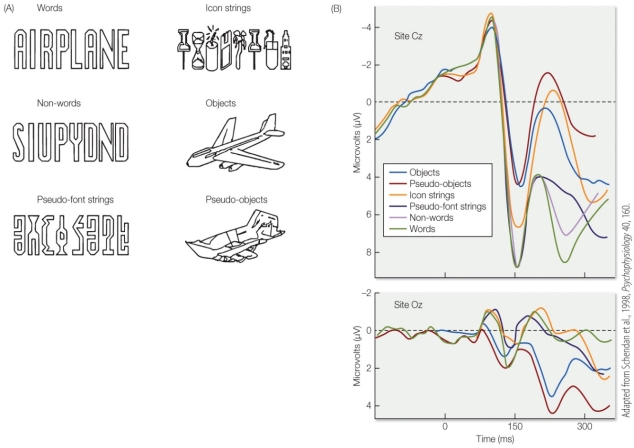 What does the figure suggest about how the brain distinguishes between words and icons or objects?
What does the figure suggest about how the brain distinguishes between words and icons or objects?
 What does the figure suggest about how the brain distinguishes between words and icons or objects?
What does the figure suggest about how the brain distinguishes between words and icons or objects?
Unlock Deck
Unlock for access to all 41 flashcards in this deck.
Unlock Deck
k this deck



